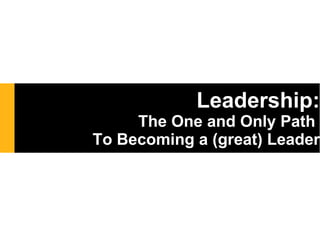Leadership: The One and Only Path To Becoming a (great) Leader
•Télécharger en tant que ODP, PDF•
13 j'aime•2,700 vues
Leadership: The One and Only Path To Becoming a (great) Leader
Signaler
Partager
Signaler
Partager

Recommandé
Recommandé
Contenu connexe
Tendances
Tendances (20)
Summary of leadership theories and management comparison

Summary of leadership theories and management comparison
En vedette
En vedette (10)
Learn to Transform Yourself from an Expert to Thought Leader - Mitchell Levy

Learn to Transform Yourself from an Expert to Thought Leader - Mitchell Levy
Thought Leadership--What is it and how do I become a leader?

Thought Leadership--What is it and how do I become a leader?
Why You Need A Customer Persona: Stories need characters

Why You Need A Customer Persona: Stories need characters
Marketing Funnel, Customer Journey & Persona Mapping by VirtualCMO Feb 2014

Marketing Funnel, Customer Journey & Persona Mapping by VirtualCMO Feb 2014
Similaire à Leadership: The One and Only Path To Becoming a (great) Leader
Similaire à Leadership: The One and Only Path To Becoming a (great) Leader (20)
MGMT331 LESSON 1Leader as a Visionary LESSON TO.docx

MGMT331 LESSON 1Leader as a Visionary LESSON TO.docx
Leadership and Leadership StylesDefining a Leader….docx

Leadership and Leadership StylesDefining a Leader….docx
Plus de Adhika Dirgantara
Plus de Adhika Dirgantara (13)
Dernier
Falcon stands out as a top-tier P2P Invoice Discounting platform in India, bridging esteemed blue-chip companies and eager investors. Our goal is to transform the investment landscape in India by establishing a comprehensive destination for borrowers and investors with diverse profiles and needs, all while minimizing risk. What sets Falcon apart is the elimination of intermediaries such as commercial banks and depository institutions, allowing investors to enjoy higher yields.Unveiling Falcon Invoice Discounting: Leading the Way as India's Premier Bill...

Unveiling Falcon Invoice Discounting: Leading the Way as India's Premier Bill...Falcon Invoice Discounting
Dernier (20)
Falcon Invoice Discounting: Empowering Your Business Growth

Falcon Invoice Discounting: Empowering Your Business Growth
Chennai Call Gril 80022//12248 Only For Sex And High Profile Best Gril Sex Av...

Chennai Call Gril 80022//12248 Only For Sex And High Profile Best Gril Sex Av...
Unveiling Falcon Invoice Discounting: Leading the Way as India's Premier Bill...

Unveiling Falcon Invoice Discounting: Leading the Way as India's Premier Bill...
Marel Q1 2024 Investor Presentation from May 8, 2024

Marel Q1 2024 Investor Presentation from May 8, 2024
Kalyan Call Girl 98350*37198 Call Girls in Escort service book now

Kalyan Call Girl 98350*37198 Call Girls in Escort service book now
QSM Chap 10 Service Culture in Tourism and Hospitality Industry.pptx

QSM Chap 10 Service Culture in Tourism and Hospitality Industry.pptx
How to Get Started in Social Media for Art League City

How to Get Started in Social Media for Art League City
Quick Doctor In Kuwait +2773`7758`557 Kuwait Doha Qatar Dubai Abu Dhabi Sharj...

Quick Doctor In Kuwait +2773`7758`557 Kuwait Doha Qatar Dubai Abu Dhabi Sharj...
Lucknow Housewife Escorts by Sexy Bhabhi Service 8250092165

Lucknow Housewife Escorts by Sexy Bhabhi Service 8250092165
Lundin Gold - Q1 2024 Conference Call Presentation (Revised)

Lundin Gold - Q1 2024 Conference Call Presentation (Revised)
Berhampur CALL GIRL❤7091819311❤CALL GIRLS IN ESCORT SERVICE WE ARE PROVIDING

Berhampur CALL GIRL❤7091819311❤CALL GIRLS IN ESCORT SERVICE WE ARE PROVIDING
Escorts in Nungambakkam Phone 8250092165 Enjoy 24/7 Escort Service Enjoy Your...

Escorts in Nungambakkam Phone 8250092165 Enjoy 24/7 Escort Service Enjoy Your...
Leadership: The One and Only Path To Becoming a (great) Leader
- 1. Leadership: The One and Only Path To Becoming a (great) Leader
- 18. The Nine Dots Problem
